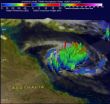(Press-News.org) Cardiometabolic risk factors, such as high blood pressure and elevated blood sugar, appear to have a bigger effect than obesity on hardening arteries early among Mexican-Americans, according to research in the Journal of the American Heart Association.
"Even among non-obese Mexican-Americans, there is already a high prevalence of clustering of cardiometabolic risk factors," said Susan T. Laing, M.D., M.Sc., lead study author and professor of cardiovascular medicine at the University of Texas Health Science Center at Houston.
"We will begin to see the impact of the high cardiovascular disease risk burden in this population over the next few decades as this relatively young minority group ages. That's why it's important to understand the magnitude and manifestations as well as the factors for cardiovascular disease development in Mexican-Americans now."
Researchers measured height, weight, body mass index (BMI), blood pressure, blood sugar and cholesterol in 503 Mexican-Americans living along the Texas-Mexico border. They measured thickness of participants' carotid artery to detect signs of atherosclerosis with ultrasound imaging.
Atherosclerosis is a condition in which the arteries gradually fill with plaque and thicken, reducing blood flow and increasing the risk for heart disease or stroke. The condition can go undetected for years.
In the study, an unhealthy metabolic profile was defined as the presence of two or more of the following risk factors: high cholesterol, high blood pressure, elevated blood sugar, elevated triglycerides, insulin resistance or elevated C-reactive protein.
Researchers found:
Nearly 78 percent of the study participants were classified as being metabolically unhealthy; more than half (52 percent) were obese (BMI of 30 or higher).
Those who were metabolically unhealthy and not obese were more likely to be male (49 percent versus 29 percent); were older (53 years versus 46 years); had a larger waist size (circumference about 38 inches versus almost 36 inches); and had less education.
Those who were metabolically unhealthy were less likely to meet the recommended guidelines for eating four to five servings of fruits and vegetables every day.
Nearly one-third of all participants had an abnormal carotid ultrasound, indicating signs of early atherosclerosis.
Researchers also found that those who weren't clinically obese but were metabolically unhealthy showed similar signs of early atherosclerosis compared with those who were obese.
The study's results suggest that metabolic risk has a greater effect on development of atherosclerosis among Mexican-Americans, whether you are obese or not. So it is important to evaluate their metabolic profiles to help reduce the risks of future heart disease, heart attack and stroke.
"Our findings are particularly relevant to future public health planning as interventions to maintain metabolic health may be a more important goal than focusing on weight loss alone," Laing said. "That's a message we should be promoting."
Mexican-Americans are part of one of the biggest ethnic groups in America, expected to account for nearly one-third of the U.S. population by 2050.
"Hispanics bear a disproportionate burden of coronary risk factors such as diabetes and obesity," Laing said. "If we are to achieve the American Heart Association's goal of improving cardiovascular health for all Americans, then we cannot ignore Americans of Mexican descent."
INFORMATION:
Co-authors are: Beverly Smulevitz, B.S.; Kristina P. Vatcheva, M.S.; Mohammad H. Rahbar, Ph.D., Belinda Reininger, DrPH.; David D. McPherson, M.D.; Joseph B. McCormick, M.D.; and Susan B. Fisher-Hoch, M.D. Author disclosures are on the manuscript.
The study was funded by The Center for Clinical and Translational Sciences, which is funded by National Institutes of Health Clinical and the National Center for Advancing Translational Sciences.
Additional Resources:
Hispanics and Heart Disease, Stroke
Weight-loss diets may reverse atherosclerosis in obese, overweight people
Researcher photo, Researcher assessing carotid artery in patient using ultrasound imaging, videos of Atherosclerosis and population, blood pressure photos and photos of fruits and vegetables are all available on the right column of this news release link: http://newsroom.heart.org/news/cardiometabolic-risk-factors-harden-arteries-early-in-mexican-americans?preview=6a21307d80bf8fcbc90580f51d58bf14
For updates and new science from JAHA, follow @JAHA_AHA.
Follow AHA/ASA news on Twitter @HeartNews.
Statements and conclusions of study authors published in American Heart Association scientific journals are solely those of the study authors and do not necessarily reflect the association's policy or position. The association makes no representation or guarantee as to their accuracy or reliability. The association receives funding primarily from individuals; foundations and corporations (including pharmaceutical, device manufacturers and other companies) also make donations and fund specific association programs and events. The association has strict policies to prevent these relationships from influencing the science content. Revenues from pharmaceutical and device corporations are available at http://www.heart.org/corporatefunding.
MINNEAPOLIS - Researchers have developed a new scoring system to help determine which elderly people may be at a higher risk of developing the memory and thinking problems that can lead to dementia, according to a new study published in the March 18, 2015, online issue of Neurology®, the medical journal of the American Academy of Neurology.
"Our goal is to identify memory issues at the earliest possible stages," said study author Ronald C. Petersen, MD, PhD, of Mayo Clinic in Rochester, Minn., and a member of the American Academy of Neurology. "Understanding what ...
ROCHESTER, Minn - Researchers at Mayo Clinic developed a new scoring system to help determine which elderly people may be at a higher risk of developing the memory and thinking problems that can lead to dementia. The study is published in the March 18, 2015, online issue of Neurology®, the medical journal of the American Academy of Neurology.
"Our goal is to identify people who are at the highest risk for dementia as early as possible" said study author Ronald Petersen, M.D., Ph.D., Chester and Debbie Cadieux Director of the Mayo Clinic Alzheimer's Disease Research ...
Preserving isolated patches of habitat isn't enough to save species such as Bachman's Sparrow (Peucaea aestivalis) that depend on longleaf pine; habitat connectivity at the landscape level is also crucial. That is the message of a new paper by Paul Taillie, M. Nils Peterson, and Christopher Moorman of North Carolina State University, published this week in The Condor: Ornithological Applications.
In the past, fire-dependent longleaf pine forests covered vast, unbroken areas of the southeastern U.S., and Bachman's Sparrows and other species adapted to live in this expansive ...
The TRMM satellite revealed that Tropical Cyclone Nathan had powerful thunderstorms known as "hot towers" near its center which are indicative of a strengthening storm.
Cyclone Nathan is located in the Coral Sea off Australia's Queensland coast. Nathan formed on March 10 near the Queensland coast triggering warnings there before moving east. Once out at sea, Nathan made a loop and headed back to Queensland.
On March 18, Nathan was nearing the Cape York Peninsula of Queensland. As a result warnings were in effect from Cape Melville to Innisfail, extending inland to Laura. ...
Modern life, with its preponderance of inadequate exposure to natural light during the day and overexposure to artificial light at night, is not conducive to the body's natural sleep/wake cycle.
It's an emerging topic in health, one that UConn Health (University of Connecticut, Farmington, Conn.) cancer epidemiologist Richard Stevens has been studying for three decades.
"It's become clear that typical lighting is affecting our physiology," Stevens says. "But lighting can be improved. We're learning that better lighting can reduce these physiological effects. By that ...
CORAL GABLES, Fla. (March 18, 2015) -- Come spring break, college students from all over the country travel to warmer climates for time off from school and to escape the cold weather. However, it's not all fun in the sun. At popular spring break destinations, fatalities from car crashes are significantly higher during the spring break weeks compared to other times of the year, according to a recent study published in the journal Economic Inquiry.
"We found that between the last week of February and the first week of April, a significantly greater number of traffic fatalities ...
There's a carbon showdown brewing in the Arctic as Earth's climate changes. On one side, thawing permafrost could release enormous amounts of long-frozen carbon into the atmosphere. On the opposing side, as high-latitude regions warm, plants will grow more quickly, which means they'll take in more carbon from the atmosphere.
Whichever side wins will have a big impact on the carbon cycle and the planet's climate. If the balance tips in favor of permafrost-released carbon, climate change could accelerate. If the balance tips in favor of carbon-consuming plants, climate ...
In 1996, a trio of scientists won the Nobel Prize for Chemistry for their discovery of Buckminsterfullerene - soccer-ball-shaped spheres of 60 joined carbon atoms that exhibit special physical properties.
Now, 20 years later, scientists have figured out how to turn them into Buckybombs.
These nanoscale explosives show potential for use in fighting cancer, with the hope that they could one day target and eliminate cancer at the cellular level - triggering tiny explosions that kill cancer cells without affecting surrounding tissue.
"Future applications would probably ...
BLOOMINGTON, Ind. -- An Indiana University cognitive scientist and collaborators have found that posture is critical in the early stages of acquiring new knowledge.
The study, conducted by Linda Smith, a professor in the IU Bloomington College of Arts and Sciences' Department of Psychological and Brain Sciences, in collaboration with a roboticist from England and a developmental psychologist from the University of Wisconsin-Madison, offers a new approach to studying the way "objects of cognition," such as words or memories of physical objects, are tied to the position ...
For generations, students have been taught the concept of "ecological succession" with examples from the plant world, such as the progression over time of plant species that establish and grow following a forest fire. Indeed, succession is arguably plant ecology's most enduring scientific contribution, and its origins with early 20th-century plant ecologists have been uncontested. Yet, this common narrative may actually be false. As posited in an article published in the March 2015 issue of The Quarterly Review of Biology, two decades before plant scientists explored the ...



